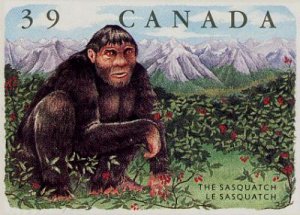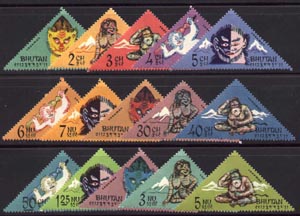|
Does Bigfoot Exist Around The World?
By George Koutrokois
 Throughout
history, stories of wild men of the woods have been told and in every corner of
the globe people have reported coming in contact with these, so called, missing
links that are said to be half man-half animal. The descriptions of this
mysterious ape like creatures are similar in most reports. They are said to
range in height from 5-9 feet tall, and are covered in hair that vary in
coloration from black and brown to grey or red. They walk upright and in most
cases try to avoid contact with humans. Many of these stories originate with
countless Indian tribes, as well as within many subcultures around the world. Throughout
history, stories of wild men of the woods have been told and in every corner of
the globe people have reported coming in contact with these, so called, missing
links that are said to be half man-half animal. The descriptions of this
mysterious ape like creatures are similar in most reports. They are said to
range in height from 5-9 feet tall, and are covered in hair that vary in
coloration from black and brown to grey or red. They walk upright and in most
cases try to avoid contact with humans. Many of these stories originate with
countless Indian tribes, as well as within many subcultures around the world.
The creature goes by many names depending on where you are from. In the Western
Hemisphere, specifically the United States, the name that is most commonly used
to describe the beast is Bigfoot, due to the size of the tracks that it leaves
behind, which ranges in size between 15 and 24 inches. Most of these sightings
occur in the Pacific Northwest, however there are also other places within the
United States that report encounters with this unknown hominid. In the
Southeastern portion of the U.S., it is commonly called, the Skunk ape because
of the stench that is associated with sightings in that region. In the North
East it is sometimes referred to as the Wood Devil, or Mountain Devil as well as
the Wild Man. In the central portions of U.S. it goes by many regional names
followed by Monster, such as the Momo: which is short for Missouri Monster. Many
places all over the U.S. have their own names for the creature depending on
where they live, and every state in the country, excluding Hawaii, has reported
seeing this, as of yet, unclassified primate.
The United States is not the only place in the western hemisphere to boast
having such a creature in their midst. Throughout Canada there have also been
many credible sightings, as well as many Indian tribe stories passed down
through generations. The name used to describe it is different; they call it
Sasquatch. The word itself is a Salish Indian name, which translates into “hairy
man”. They also call the beast by some other recognizable names, such as Rugaru
and Windigo, and a host of other Indian names depending once again on the region
that you might be traveling in. The names may be different, but the creature by
all accounts is the same.
 Another
zone famous with folklore pertaining to an unknown creature would be the
Himalayan Mountains, in the areas of Nepal and Tibet. In this region of our
world the name used to describe the manimal is Yeti, otherwise known as the
Abominable Snowman due to the snow covered land it inhabits. For centuries the
people living around this geographical area have reported seeing the same type
of bipedal anomaly, and have passed down stories to their families. To many, the
Yeti helped to ignite the Bigfoot craze in the Western Hemisphere when stories
of the beast appeared in newspapers across the United States and so called
monster hunters went searching for it in the harsh and unforbidding landscape
that is the Himalayas. Once again this area is not the only to have 1 or 2 names
for the creature. In Bhutan locals call it, the Migyur and in other remote spots
through the region it is known as the Kaptar. Another
zone famous with folklore pertaining to an unknown creature would be the
Himalayan Mountains, in the areas of Nepal and Tibet. In this region of our
world the name used to describe the manimal is Yeti, otherwise known as the
Abominable Snowman due to the snow covered land it inhabits. For centuries the
people living around this geographical area have reported seeing the same type
of bipedal anomaly, and have passed down stories to their families. To many, the
Yeti helped to ignite the Bigfoot craze in the Western Hemisphere when stories
of the beast appeared in newspapers across the United States and so called
monster hunters went searching for it in the harsh and unforbidding landscape
that is the Himalayas. Once again this area is not the only to have 1 or 2 names
for the creature. In Bhutan locals call it, the Migyur and in other remote spots
through the region it is known as the Kaptar.
In South America, they have a version of Bigfoot as well. In Brazil, the Amazon
rain forest conceals many animals not yet classified by modern science, and the
Mapinguari is no exception. The name translates to Giant Defenders of the
Forest. These giants are reported, by some, to be close to 10 feet tall and
covered in fur and local tribes believe that they protect the areas that they
inhabit. A little further south in Argentina, the creature is called Ucumar.
Once again, different names for the same type of animal depending on where you
are geographically.
Moving on to the other side of the Earth, people throughout the Far East have
also seen this unknown being. In China, the locals call it Ye-ren; which means
Wildman. Accounts date back over thousands of years, well before there was any
contact with any western society. Even in Japan, specifically in the Hiroshima
mountains, locals speak of a creature called Hibagon, Kappa or
Mu-Jimi.
In Indonesia, specifically in Sumatra, tribes speak of the little man of the
forest called Orang-pendek. It is reported to be smaller than its western
cousins, being only around 5 feet tall with chocolaty-brown or orange tinted
hair. It was written that Marco Polo encountered one of these animals during his
travels there in 1292.
In the Philippines, they call it Kapre. In Vietnam, locals and even U.S.
servicemen came into contact with a beast they called a rock ape. They also
speak of Nguoi rung, the forest people and the appearances are similar to that
of the Wildman of China. In Malaysia it is known as Mawa. In Sri Lanka, the
Nittaewo is rumored to exist. Africa has creatures that are similar as well. The
Democratic Republic of Congo talk of a beast called the Lion Eater and in West
Central Africa, they call it the Koolakamba. Down under in Australia, Local
tribes such as the Aborigines tell stories of the Yowie, which means devil or
evil spirit, and in New Zealand it has been named Moehau.
Russians are no strangers to these unknown animals either. They have dubbed the
thing Almas, a name that Mongolians also use to describe it. In Siberia it is
named Chuchunaa. Finally in the Caucasus Region they are called Almos and
Abnauayu.
It is conceivable that these creatures have existed, along with humans, since
the dawn of man. According to the Nature Conservancy, a secret population of
orangutans was discovered in 2002 in the forests on the island of Borneo.
Conservationists still believe that about 2000 rare, unclassified apes are
living out of sight in a remote lowland region of East Kalimantan, which is in
Indonesia. If these creatures are still being discovered today, why can’t a
population of other unknown primates be elsewhere throughout our vast planet?
The photos appear here under the fair
use
for educational purposes of copyright material. |